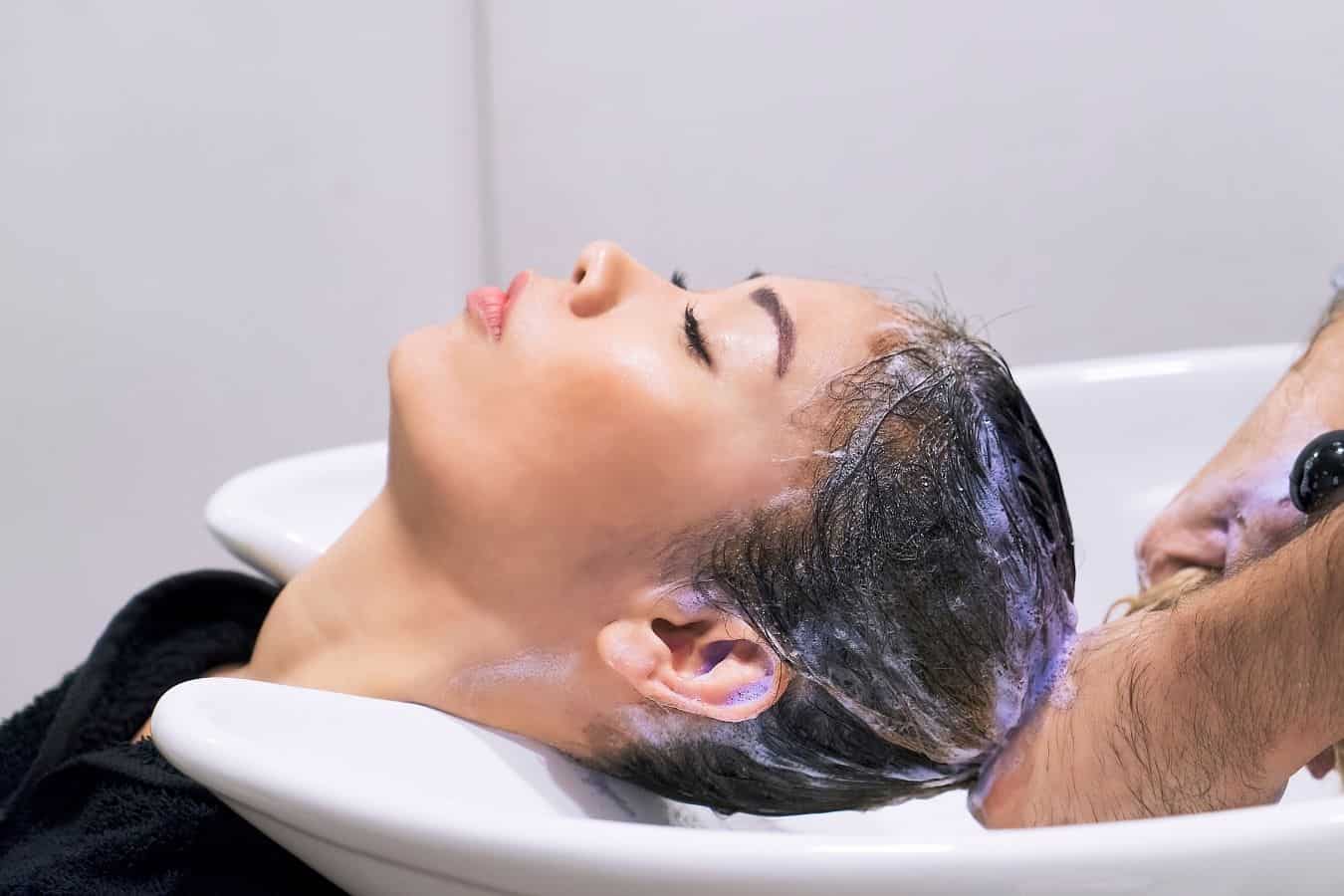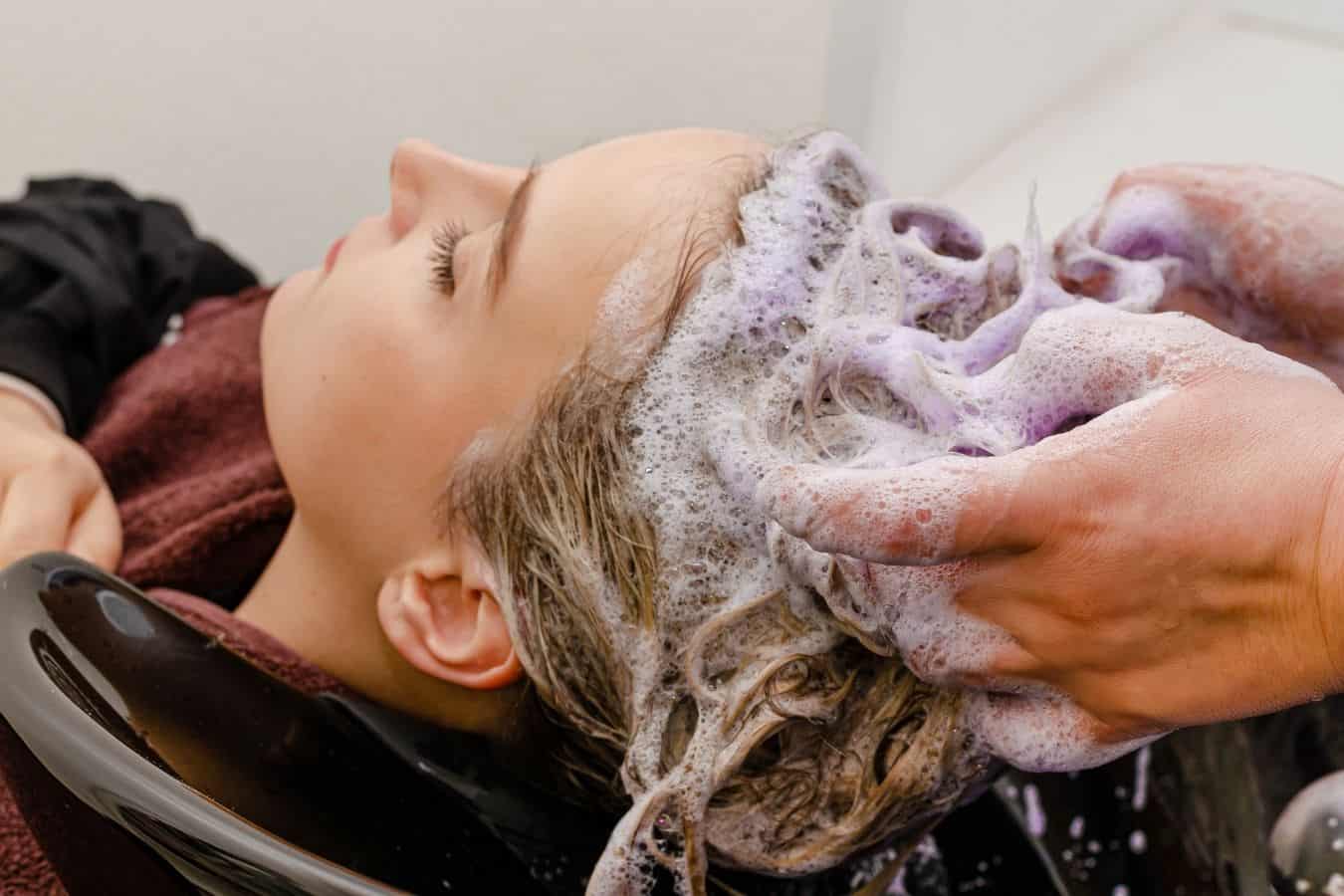There’s recently been a hair hack floating around on the internet that advocates the use of purple shampoo on dry hair. The argument is that purple shampoo can absorb into the hair more easily when it’s dry as it’s not diluted with water, creating a greater toning effect for blonde hair.
So, let’s take a look at this claim. Is applying purple shampoo to dry hair a good idea? What are the risks and are there better alternatives?

In short, it is not recommended that you apply purple shampoo to dry hair. It is difficult to do, is messy, and can result in an uneven tone all over your hair. Always follow the instructions on the back of the product.
This post contains affiliate links and we may earn if you click on them (at no extra cost to you). Please read our full disclosure policy here.
In a rush? Here’s our 5 favorite purple shampoos:
Fudge Professional Purple Toning Shampoo
PRO:VOKE Touch of Silver Brightening Shampoo
John Frieda Sheer Blonde Violet Crush Tone Correcting Purple Shampoo
Clairol Shimmer Lights Shampoo for Blonde and Silver Hair
What Is Purple Shampoo?
Purple shampoo is an ideal treatment for all shades of blonde, gray, and even light brunettes. It helps to neutralize brassy, orangey, and yellow shades in hair. This keeps it looking fresh and cool.
Brassiness happens when the bleaching or lifting process doesn’t remove all the underlying warm tones from your hair.
This usually results in the lightened hair having a yellow or orangey tone.
The darker your hair is, the more likely you are to have brassiness if your hair is lightened. This could be a lighter shade of brown or platinum blonde.
Brassiness can also be caused by exposure to the sun, heat styling, and chemicals in water.
Luckily, purple shampoo is an easy and convenient way to cool down these yellow and orangey tones in your hair.
Also Read: 10 Best pH Balanced Hair Products To Try In 2021
How Does Purple Shampoo Work?
Purple shampoo works by canceling out brassy tones. This is because purple is the opposite of yellow and orange on the color wheel.
This means the purple is able to cancel out the yellow and orange tones in hair, leaving blonde and grey hair looking cool and ashy. Clever, right?
It should be noted that purple shampoo only stains the hair and does not dye it permanently. Rather than entering the hair shaft it sits on the cuticle.
So, what is the best way to use it?
Can I Use Purple Shampoo On Dry Hair?
The argument for using purple shampoo on dry hair is that the pigments in purple shampoo will cling more effectively to dry hair because it is more porous than wet hair.
We wouldn’t recommend using purple shampoo on dry hair, however.
It’s very messy, uses a lot of product, and can produce uneven results.
The purple shampoo may also absorb unevenly due to your hair’s porosity. This may not be consistent through the lengths of your hair.
If your hair is bleached, for example, there’s a good chance you have damaged ends.
The purple shampoo would take more to the ends or to highlights where porosity is higher.
The result may be that you find you have purple streaks or patches in your hair!
Applying purple shampoo to dry hair would probably only work if your hair is short, recently trimmed, and dyed all over, rather than highlighted.
But even then, we would suggest you proceed with caution. Using purple shampoo as a traditional shampoo, in the shower, is far easier.
If you’re not happy with the resulting tone, you can always repeat the process.
The Right Way To Use Purple Shampoo

The best and most risk-free way to use purple shampoo is to use it on wet hair, in place of your usual shampoo.
Always make sure you follow the instructions on the product packaging. All purple shampoos are different, but what follows is a general guide.
Wet Your Hair
First soak your hair in the shower. If your ends are dry, it may be a good idea to condition them first and then rinse them out. This is because dryer ends may be more porous and may end up with a purplish tinge.
Apply Purple Shampoo
Then take a small amount of purple shampoo (about the size of a dime) and massage it evenly through your hair, Start at the scalp and working through to the ends.
How long you leave it in depends on the product and the porosity of your hair, but about five minutes is a general guide.
Rinse Out
Rinse out the shampoo and follow with conditioner, as purple shampoo can be drying for hair.
You can use your regular conditioner or a heated deep conditioner, or follow up with a matching purple conditioner. This will help maximize the effects of your shampoo.
If you want to play it safe and start small, you could try adding a bit of purple shampoo to your usual favorite shampoo or co-wash, to create a gentle toning effect.
This is a good option if your hair is very porous and you’re worried about it turning purple.
Also Read: How to Tame Frizzy Hair Overnight (5 Easy Hacks)
What Happens If I Leave Purple Shampoo In My Hair Too Long?
The longer you leave purple shampoo to develop in your hair, and the more often you use it, the more intense the toning result will be and the cooler your resulting shade.
A word of caution, however. If it is a pigmented, color depositing purple shampoo you’re using, your hair will develop a purple tint if you leave the shampoo in your hair for too long.
What counts as “too long” will vary by brand and the porosity of your hair.
Always read the packaging of your chosen purple shampoo before using it.
What If My Hair Turns Purple?
If your hair has gone purple, don’t panic.
The pigments do not enter the hair shaft as purple toning shampoo is a stain, not a dye.
This means it will wash out over time. You might even find you like the effect!
But if you hate it, and you want to get the purple tint out of your hair as fast as possible, use a clarifying shampoo.
This will help to remove the color much faster.
Very light bleached hair is very porous, so you run a high risk of going purple if you leave the shampoo in for too long.
You will probably find that the more bleached and damaged your hair is, the more likely the purple pigment is to stick to your hair.
If you have very light bleached hair, you may find the purple tint is difficult to get out. If the purple stain just won’t budge, it’s probably time to call your stylist for a color correction.
As purple shampoo can be quite drying for the hair, especially if you leave it in for too long, it would be wise to follow up with a conditioner or a hair mask.
How Often Should I Use Purple Shampoo?

This depends on the color you have.
If you have a warmer golden blonde hue, you may only want to use purple shampoo as and when your hair starts to look too warm and brassy.
If you have a head of platinum blonde hair, you’ll want to use it regularly to keep your shade looking cool.
The general rule is, the more you use purple shampoo, the more intense its effects will be.
If you’re new to using purple shampoo, it’s best to start off with using it once a week and take it from there.
You may want to use it more or less depending on the results and the shade of your hair.
No matter what level of toning you’re looking for, we still wouldn’t recommend that you apply purple shampoo on dry hair. It is simply too difficult to get a good, even tone by doing it this way.
As purple shampoo can be drying for the hair (as is bleaching and highlighting the hair), wash your hair as little as possible between toning with purple shampoo. Use a gentle shampoo and cool or lukewarm water.
It’s also good to deep condition your hair regularly to keep it in the best possible condition.
Also Read: Is Sea Salt Good For Your Hair (And How To Use It)
Alternative Ways To Prevent Brassy Tones
If you don’t fancy trying purple shampoo, or are looking for some other ways to help reduce the brassiness of your hair, here are some other suggestions you can incorporate into your daily hair care routine.
Use A Toner Or Gloss
This is a simple step you can take to immediately lift the brassiness out of your hair with the minimum of fuss. Get a toner or a demi-permanent gloss. These will immediately correct your hair color and remove brassiness. This process can be done by your stylist or you can pick up a toner or gloss quite cheaply at the drugstore. They’re simple to use and are probably the fastest and easiest way to remove brassy tones.
Use Cool Water To Wash Hair
This is something you should be doing every wash day to help preserve your color and keep brassiness at bay. Hot water opens up the cuticles of the hair, allowing hair color to fade faster. Washing your hair with cool or lukewarm water greatly slows down this process, helping to preserve your shade.
Wear A Swim Cap In The Pool
Chlorine is one of the worst things for colored hair. It strips hair of moisture, leaving your strands dry and brittle and more prone to going yellow or orangey. Dosing your hair in clean water before getting in the pool goes some way to preventing this, as fully saturated hair will not soak up as much chlorine. However, a swim cap is the most effective form of protection. If you color your hair and like to visit your local pool regularly, always wear a swim cap.
Use Heat Protection When Styling
Heat styling your hair by blow-drying and using straighteners or tongs not only damages your hair, it also causes your color to fade faster, bringing out brassiness. Invest in a good heat protection spray and spritz your hair from root to tip before heat styling to protect it from damage.
Protect Your Hair From The Sun
The sun is another big culprit for brassy hair. This is because the sun’s UV rays lighten hair over time, causing brassiness to emerge. Protect your hair from fading by keeping it covered or by using a UV protection spray.
Disclaimer: This site is not intended to provide professional or medical advice. All of the content on LovedByCurls.com is for informational purposes only. All advice should be followed at your own discretion. Ingredients may change at any time so always check the product label before using. Check our full disclaimer policy here.
